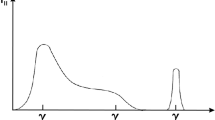Abstract
On exoplanets with a weak magnetic field, the so-called plasma maser can be effectively implemented instead of an electron cyclotron maser. This maser involves the generation of plasma waves by energetic electrons and their conversion into radio emissions at the plasma frequency or at the double frequency. Under specific conditions, a maser effect occurs at the plasma frequency, which manifests itself in an exponential increase in radio emissions intensity with an increase in the energy of plasma waves. In this paper, we study the Raman scattering of excited plasma waves with the formation of an electromagnetic wave at the double plasma frequency in the plasmasphere of the exoplanet HD189733b, for which the three-dimensional structure of the plasma envelope has been studied. Although the maser effect is absent in the case of Raman scattering, the collisional absorption of radiation is significantly reduced at the second harmonic and the requirement for the brightness temperature in the source is reduced as well. It has been shown that the radio flux at the second harmonic increases sharply for this exoplanet from a few millijanskys at a frequency of 20 MHz to tens of janskys at a frequency of ≈4 MHz. This means that the decameter range near the cutoff frequency of the Earth’s ionosphere is the most promising range for the detection of second harmonic radio emissions by modern radio telescopes. In this case, the radio emissions of the second harmonic can provide information about the properties of plasmaspheres around exoplanets at considerable distances that are inaccessible during observations at the main plasma frequencies.



Similar content being viewed by others
REFERENCES
de Gasperin, F., Lazio, T.J., and Knapp, M., Radio observations of HD 80606 near planetary periastron. II. LOFA-R low band antenna observations at 30–78 MHz, Astron. Astrophys., 2020, vol. 644, p. A157. https://doi.org/10.1051/0004-6361/202038746
Grießmeier, J.-M., Zarka, P., and Spreeuw, H., Predicting low-frequency radio fluxes of known extrasolar planets, Astron. Astrophys., 2007, vol. 475, pp. 359–368. https://doi.org/10.1051/0004-6361:20077397
Narang, M., Manoj, P., Ishwara Chandra, C. H., et al., In search of radio emission from exoplanets: GMRT observations of the binary system HD 41004, Mon. Not. R. Astron. Soc., 2021, vol. 500, pp. 4818–4826. https://doi.org/10.1093/mnras/staa3565
Reiners, A. and Christensen, U.R., A magnetic field evolution scenario for brown dwarfs and giant planets, Astron. Astrophys., 2010, vol. 522, p. A13. https://doi.org/10.1051/0004-6361/201014251
Rosenbluth, M.N. and Post, R.F., High-frequency electrostatic plasma instability inherent to “loss-cone” particle distributions, Phys. Fluids, 1965, vol. 8, no. 3, pp. 547–550. https://doi.org/10.1063/1.1761261
Rumenskikh, M.S., Shaikhislamov, I.F., Khidachenko, M.L., et al., Global 3D simulation of the upper atmosphere of HD189733b and absorption in metastable HeI and Ly α lines, Astrophys. J., 2022, vol. 927, no. 2, p. 238. https://doi.org/10.3847/1538-4357/ac441d
Stepanov, A.V., Kliem, B., Kruger, A., et al., Second-harmonic plasma radiation of magnetically trapped electrons in stellar coronae, Astrophys. J., 1999, vol. 524, pp. 961–973.
Turner, J., Zarka, P., Grießmeier, J.-M., et al., The search for radio emission from the exoplanetary systems 55 Cancri, υ Andromedae, and τ Boötis using LOFAR beam-formed observations, Astron. Astrophys., 2021, vol. 645, p. A59. https://doiorg/https://doi.org/10.1051/0004-6361/201937201.
Weber, C., Lammer, H., Sheikhislamov, I.F., et al., How expanded ionospheres of radio emission generated by the cyclotron maser instability, Mon. Not. R. Astron. Soc., 2017, vol. 469, pp. 3505–3517. https://doi.org/10.1093/mnras/stx1099
Zaitsev, V.V. and Stepanov, A.V., On the origin of fast drift absorption bursts, Astron. Astrophys., 1975, vol. 45, pp. 135–140.
Zaitsev, V.V. and Shaposhnikov, V.E., Plasma maser in the plasmasphere of HD 189733b, Mon. Not. R. Astron. Soc., 2022, vol. 513, pp. 4082–4089. https://doi.org/10.1093/mnras/stac1140
Zheleznyakov, V.V., Radiation in Astrophysical Plasmas, Dordrecht: Kluwer Academic, 1996.
Funding
The study was supported by the Russian Science Foundation under grant no. 23-22-00014 (Sections 1, 3, 4) and the State Assignment FFUF-2023-0002 (Section 2).
Author information
Authors and Affiliations
Corresponding authors
Ethics declarations
The authors declare that they have no conflicts of interest.
Additional information
Translated by M. Chubarova
Publisher’s Note.
Pleiades Publishing remains neutral with regard to jurisdictional claims in published maps and institutional affiliations.
Rights and permissions
About this article
Cite this article
Zaitsev, V.V., Shaposhnikov, V.E., Khodachenko, M.L. et al. On the Efficiency of Radio Emissions at the Double Plasma Frequency in the Magnetosphere of Exoplanet HD189733b. Geomagn. Aeron. 63, 892–898 (2023). https://doi.org/10.1134/S0016793223070307
Received:
Revised:
Accepted:
Published:
Issue Date:
DOI: https://doi.org/10.1134/S0016793223070307




